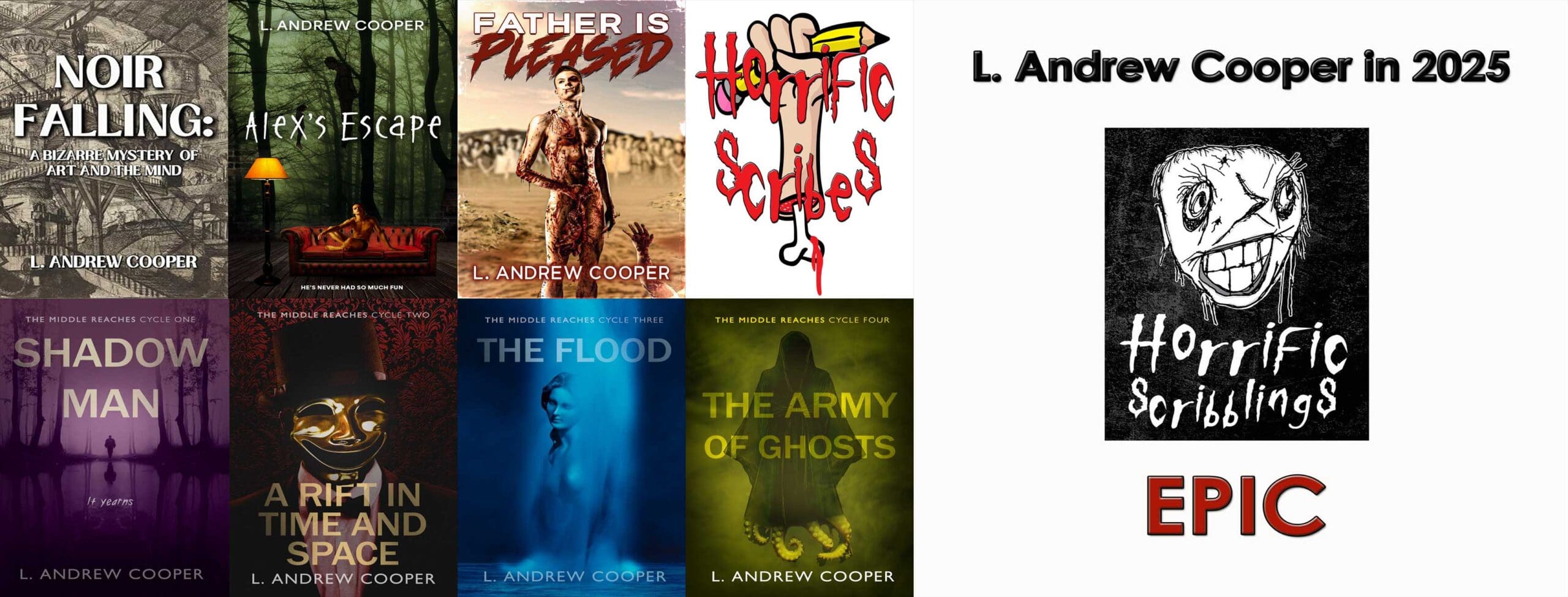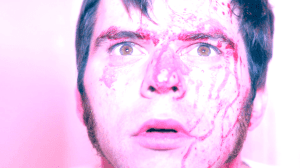Spotlight: Mike Lombardo’s “The Stall,” “Play Place,” and “I’m Dreaming of a White Doomsday”
Mike Lombardo is the lead writer/director of Reel Splatter Productions, and this spotlight falls on three of his recent, interrelated efforts: two short stories, “Play Place” and the timely “I’m Dreaming of a White Doomsday,” and the star of the show, his most recent short horror film, “The Stall.”
Cover copy describes “The Stall” as a “horror comedy” in which “a pizza shop employee faces blasphemous terrors from outside time and space when he finds himself trapped in the restroom during the Lovecraftian apocalypse.”
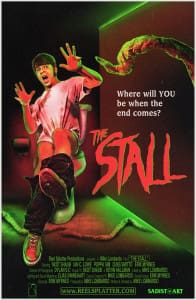 If the premise isn’t enough to make you commit less than a quarter hour of your life to checking out this film or similar chunks of time to reading Mr. Lombardo’s creepy stories, perhaps the rich personal and thematic layers within the work that this interview touches on will draw you in. And you might also check out my review, which is here.
If the premise isn’t enough to make you commit less than a quarter hour of your life to checking out this film or similar chunks of time to reading Mr. Lombardo’s creepy stories, perhaps the rich personal and thematic layers within the work that this interview touches on will draw you in. And you might also check out my review, which is here.
An Interview with Mike Lombardo, December, 2013
LAC: I have to admit, the premise was almost enough to make me an immediate Lombardo fan, but to get from premise to execution—from the funny idea of having the world end while a guy sits on the toilet to actually making a good, longer-than-a-punchline film with that idea—took courage, because the premise could go wrong in so many ways. I know it was a long labor of love: what kept you inspired enough to bring this idea all the way to the screen?
ML: A pizza shop employee faces blasphemous terrors from outside time and space when he finds himself trapped in the restroom during the Lovecraftian apocalypse.
It was indeed a long labor, nearly two and half years to be exact, and that was just the original production and reshoots. The actual script idea is even older than that. I have always wanted to do something Lovecraftian, as H.P. Lovecraft’s work has been a very big influence on me, and I have an unhealthy obsession with creature movies and slime, so it was a natural choice for me. The impetus to get cross the finish line with the movie, however, was much more personal than a love of rubber tentacles.
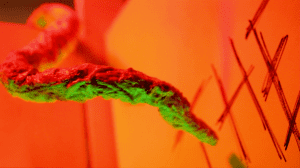 During the production of “The Stall” I was having a really rough time of things. I was dealing with the aftermath of a serious long term relationship ending, and shortly afterward my mom was hospitalized with kidney failure and nearly died during the couple months she spent there. In addition to that, over the course of production I lost two friends to cancer and my father passed away from a blood infection. My life tanked out pretty bad for awhile, and one morning I woke up and realized that if I didn’t do something, things were going to get very, very bad, so I buried myself in “The Stall.” In all honesty, if I didn’t have the movie to work on, I would have gone off the deep end. I always joke with people that indie filmmaking doesn’t pay the bills, but it keeps the gun out my mouth, at that point in time it wasn’t such a funny joke.
During the production of “The Stall” I was having a really rough time of things. I was dealing with the aftermath of a serious long term relationship ending, and shortly afterward my mom was hospitalized with kidney failure and nearly died during the couple months she spent there. In addition to that, over the course of production I lost two friends to cancer and my father passed away from a blood infection. My life tanked out pretty bad for awhile, and one morning I woke up and realized that if I didn’t do something, things were going to get very, very bad, so I buried myself in “The Stall.” In all honesty, if I didn’t have the movie to work on, I would have gone off the deep end. I always joke with people that indie filmmaking doesn’t pay the bills, but it keeps the gun out my mouth, at that point in time it wasn’t such a funny joke.
LAC: I find that the film’s actual humor comes mostly from the early depiction of everyday life at the pizza parlor. Since I don’t find anything humorous about simply seeing a guy on the toilet, almost every moment shot in the stall feels quite serious and increasingly intense. Even the gore, which from the outside (mainly tentacles and buckets of blood) probably seems funny, plays pretty straight in the narrative, which contrasts with the often used-for-laughs handmade effects that are hallmarks of “Long Pig” and other Reel Splatter films. Do you find that I’m typical—are your audiences generally taking “The Stall” more seriously? What’s a (real or imaginary) reaction to this film, sales considerations aside, that you’d like so much that you’d brag about it? Finally, even though you still take pride in “putting the laughter back in slaughter,” do you see your visceral aesthetics necessarily leading you down paths of even lesser levity? Why or why not?
ML: The fear I had of this movie falling completely flat was nearly all consuming during the production. I really wanted to do something in a more serious vein, and picking a story about a guy on the toilet was a risky choice. I really wanted to downplay the comedy in this one and play with something more along the straight horror lines, which is a very big departure for me. I didn’t know how the fans of old Reel Splatter were going to take it, so that scared the hell out of me during the production. The only comedy elements come from the pizza shop stuff. I wanted the movie to completely shift tones when we got into the bathroom. From the beginning I knew that it had to be played straight, despite the premise. I didn’t want there to be even the slightest hint of toilet humor, and that was part of the fun for me. My greatest joy in filmmaking is subverting the audience’s expectations, and I think that “The Stall” is one of my most successful attempts at that. Everyone thinks they are going to be subjected to one big shit joke, and when the movie finally gets into the bathroom, the comedy ends, and things take a turn for the horrific, which is the complete opposite thing they are expecting to happen. It really catches people off guard, and it’s wonderful to see the audience reaction when everything changes: they go from smirking and laughing to complete open-mouthed silence.
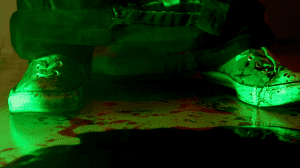 I really wanted the end segment to be a sort of assault on the senses. With the lights and sound design, I wanted to build up the intensity and really suck people into it. So far, it’s been very successful in doing that; I’ve had the pleasure of seeing many people jump out of their seats at screenings, and when the credits start to roll, people are left just kind of staring at the screen in silence, and then they turn to me and say, “Holy shit,” which is really nice. The biggest compliments I’ve gotten, though, are from Lovecraft fans. I have gotten some really awesome reviews from folks who know his work in and out, and it pleases me greatly to hear them say that all the Lovecraft in-jokes and references aside, the movie is actually very thematically Lovecraftian. I really wanted to nail the atmosphere and tone of his work, and it’s a real challenge to try to be scary without actually showing a lot of what’s going on.
I really wanted the end segment to be a sort of assault on the senses. With the lights and sound design, I wanted to build up the intensity and really suck people into it. So far, it’s been very successful in doing that; I’ve had the pleasure of seeing many people jump out of their seats at screenings, and when the credits start to roll, people are left just kind of staring at the screen in silence, and then they turn to me and say, “Holy shit,” which is really nice. The biggest compliments I’ve gotten, though, are from Lovecraft fans. I have gotten some really awesome reviews from folks who know his work in and out, and it pleases me greatly to hear them say that all the Lovecraft in-jokes and references aside, the movie is actually very thematically Lovecraftian. I really wanted to nail the atmosphere and tone of his work, and it’s a real challenge to try to be scary without actually showing a lot of what’s going on.
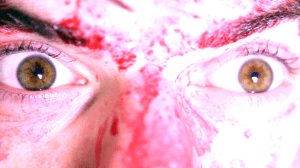 I think I surprised a lot of people with “The Stall;” it’s extremely different in tone and execution from the old Reel Splatter stuff, and I definitely would like to try doing some more projects along these lines. I have a lot of scripts I’ve been mulling over for years that are more serious. I just never had the crew and equipment to pull them off. That’s changed now, and I am certainly a lot more confident in my tech skills and ability to tell a story and work with direct actors, so it’s definitely something that is going to be explored in the near future. Really I suppose it depends on what fits the story. I don’t generally think about the tone too much when I’m writing. I just sort of let it happen and edit it down later. I don’t think I’ll ever leave the comedy out completely, though; that really is my strong suit, and satire is my favorite form of self-expression.
I think I surprised a lot of people with “The Stall;” it’s extremely different in tone and execution from the old Reel Splatter stuff, and I definitely would like to try doing some more projects along these lines. I have a lot of scripts I’ve been mulling over for years that are more serious. I just never had the crew and equipment to pull them off. That’s changed now, and I am certainly a lot more confident in my tech skills and ability to tell a story and work with direct actors, so it’s definitely something that is going to be explored in the near future. Really I suppose it depends on what fits the story. I don’t generally think about the tone too much when I’m writing. I just sort of let it happen and edit it down later. I don’t think I’ll ever leave the comedy out completely, though; that really is my strong suit, and satire is my favorite form of self-expression.
LAC: You may not have been able to answer the previous question without thinking about your prose fiction, which lacks the lighter tones of your films. You’ve published two stories in StrangeHouse Books anthologies, “Play Place” in Zombie! Zombie! Brain Bang!: A Strange Anthology (2012) and “I’m Dreaming of a White Doomsday” in A Very StrangeHouse Christmas (2013). Both tales are apocalyptic, “Play Place” featuring a zombie plague (also a subject in early films in your Suburban Holocaust collection), and “Doomsday” featuring conditions a bit more like the Lovecraftian future glimpsed in “The Stall.” Two related questions here. First, why do you think your imagination keeps beginning at The End? Second, one figure, Dr. Chud, visually unifies your films and your prose—do you imagine unifying your apocalypses further to create your own Lovecraft-like mythos?
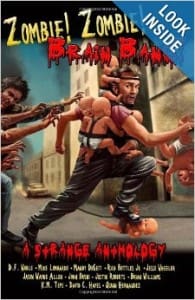 ML: I wish I knew why my imagination always ends up at the apocalypse. I’ve had a fascination with the end of the world for as long as I can remember. One of my favorite things to do is to go for long walks around my neighborhood at 3 in the morning and pretend the empty suburban streets are a post apocalyptic wasteland.
ML: I wish I knew why my imagination always ends up at the apocalypse. I’ve had a fascination with the end of the world for as long as I can remember. One of my favorite things to do is to go for long walks around my neighborhood at 3 in the morning and pretend the empty suburban streets are a post apocalyptic wasteland.
In “Play Place” I wanted to use the apocalypse as a metaphor for the world the main character knows coming to an end and fear he feels at being left to this uncertain future. In “I’m Dreaming of a White Doomsday,” it served as allegory for the often harsh and cruel events that life throws at you, and how it all distorts and changes you as a person. That all sounds terribly pretentious. How about this? I think the end of the world is really neat-o and I love the visuals of deserted streets filled with the wreckage of a dead civilization. Oh, and skeletons. Skeletons are totally boss.
Dr. Chud does show up quite a bit doesn’t he?
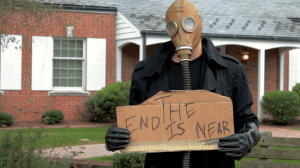
I honestly don’t think I have the cognitive capacity to upkeep my own mythos. I like having the freedom of changing the logic and rules whenever I want without the restraints that come with creating one world to set your stories in. I do like to make reference to other films within my other work to keep stuff in a kind of universe but I never really gave much thought to unifying it into one cohesive world. I do try to keep one constant thing among all of my film work: with the exception of “The Stall,” no one ever questions any of the morally reprehensible and bizarre things that go on. In my world it’s totally normal for a 16 year old fetus to be living inside his mother’s womb or for a man to steal someone’s breath to stay young. I love the complete acceptance of the surreal.
LAC: You’ve mentioned that you might adapt “I’m Dreaming of a White Doomsday” for film. That raises a few questions. First, about your creative process: was envisioning and writing these stories very different from envisioning and writing treatments and screenplays? Specifically, did you imagine “Doomsday” differently as a short story, or did you imagine it like a movie? Finally, why are you drawn to “Doomsday” for adaptation?
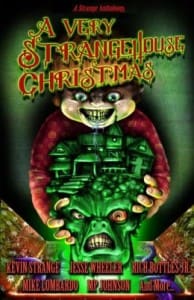 ML: When I originally conceived both “Play Place” (which I would LOVE to adapt someday when someone gives me a large sum of money to play with) and “I’m Dreaming of a White Doomsday” I was thinking in terms of film. I always think from the point of view of a movie when I write. When I realized the large scope of doing either of them as films, I switched gears and wrote them as prose, though I always have the visuals in my head that I would like to shoot. “Doomsday” I changed a lot from the original concept for logistical reasons. The film version I had envisioned was much more heavily visual based, especially the segments with Santa, but when I wrote the prose version, I was really able to expand the backstory and flesh out the characters, and of course I don’t have to worry about a budget or finding actors when I’m writing fiction.
ML: When I originally conceived both “Play Place” (which I would LOVE to adapt someday when someone gives me a large sum of money to play with) and “I’m Dreaming of a White Doomsday” I was thinking in terms of film. I always think from the point of view of a movie when I write. When I realized the large scope of doing either of them as films, I switched gears and wrote them as prose, though I always have the visuals in my head that I would like to shoot. “Doomsday” I changed a lot from the original concept for logistical reasons. The film version I had envisioned was much more heavily visual based, especially the segments with Santa, but when I wrote the prose version, I was really able to expand the backstory and flesh out the characters, and of course I don’t have to worry about a budget or finding actors when I’m writing fiction.
I am drawn to “Doomsday” for a film adaptation for a couple of reasons. First, it fulfills my sick obsession with Santa Claus, the apocalypse, and gas masks. Those three things pop up in my imagination more than I care to admit here. I also really love the story; it’s a pretty personal tale that really resonates with the current state of my life, and above all else, I just think it would make for an interesting movie.
LAC: How do you feel about the idea of being a horror “auteur”? Your work is more honestly autobiographical than much work in the genre. The arrangement of films on Suburban Holocaust provides a clear perspective on your development as an artist (and human) both on camera and off. “Play Place” and “The Stall” both deal with apocalyptic scenarios layered atop grotesque characterizations of the food service industry, where you have some professional experience. Why do you think you’re able to take a genre that so many people see as “far out” so personally? In art films, where one is more apt to find open autobiography, knowing the story’s connection to a real person enriches it. So too in horror. Therefore, a leap: is the kid in “Doomsday” your innocence?
ML: I have been an artistically minded individual since I was a child, and I have been in love with horror, comedy, and the delightful mixture of the two for just as long. I grew up being mocked because of the “weird shit” I loved, and it instilled in me a desire to prove that art doesn’t have to be a super highbrow, esoteric piece in a gallery to have legitimacy. Reel Splatter has come to encompass all of my creative endeavors, be it film, FX, prose or other, and my official mission statement since the beginning of Reel Splatter has been “to prove that artistic expression can involve necrophilia and chainsaws”. It always frustrated me that the inclusion of horror or comedy instantly downgrades something to trash in the eyes of people. So many times strangers will overhear that I am a filmmaker and excitedly ask what type of movies I make, and when I say horror, they get sour looks on their faces and mutter “Oh, you make THOSE types of movies” and instantly change the subject. I think that as a genre, horror, and especially horror comedy, is the perfect vehicle for self expression. After all, what is more personal than our fears? And what better way to deal with them than making light of them with satire?
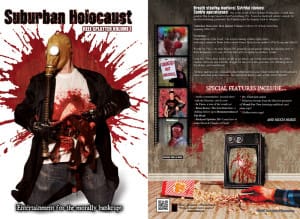 The cover art of Suburban Holocaust is Dr.Chud (our gas mask clad mascot) tearing open his own stomach and pulling film, not intestines, out of the wound. This was based on an extremely vivid dream I had once. The image of Dr.Chud tearing himself open, exposing the inner workings of himself to the viewer is an allegory of my creative process. Every film and especially every piece of prose I write is an act of masochism. I tear into myself and expose the guts of my psyche. Everything I write and direct is extremely personal. It may not be entirely apparent to the audience, but all of the bizarre and seemingly random things in all of my films and stories are rooted in some sort of personal reflection. This has been a difficult thing to deal with over the years, as I tend to hide the more personal aspects of the flick or story with comedy. It’s how I deal with my own insecurities and fears, which is ironic because one of my biggest ones is not being taken seriously. Pouring your absolute heart out and exposing your secret fears in something that people might dismiss with a chuckle can be very difficult. It’s an idea that I plan on exploring very in depth in my first feature length film, Masterwork, which is going to be the most autobiographical thing I’ve ever written. If you read “Play Place” or watch “The Stall,” it’s pretty apparent that I am not happy with my life in food service. I’ve been working at the same pizza shop (where we actually filmed the bulk of “The Stall”) for 11 years. It pays my bills and allows me to do the movie stuff on the side, but I’ve become very comfortable there, and it is soul-killingly tedious. Despite my unhappiness, I’ve been there so long I’m afraid to leave and try something new. My greatest fear is dying at work. I have this recurring nightmare scenario where I am trapped in the restaurant and in my final moments, I realize that I wasted away my life in food service when I should have been out following my dreams and making films. The idea that the summation of my life, all of the things I have created, the people I’ve met, everything I’ve experienced, ends in a cold, dirty bathroom stall at the pizza shop is the most terrifying thing I can imagine. That is the point of “The Stall” for me. A man trapped in the confines of a place he feels is safe and comfortable, afraid to leave because he is terrified of the unknown horrors lurking outside. I felt like Lovecraft’s obsession with the fear of the unknown was the perfect way to express my own feelings about my current life.
The cover art of Suburban Holocaust is Dr.Chud (our gas mask clad mascot) tearing open his own stomach and pulling film, not intestines, out of the wound. This was based on an extremely vivid dream I had once. The image of Dr.Chud tearing himself open, exposing the inner workings of himself to the viewer is an allegory of my creative process. Every film and especially every piece of prose I write is an act of masochism. I tear into myself and expose the guts of my psyche. Everything I write and direct is extremely personal. It may not be entirely apparent to the audience, but all of the bizarre and seemingly random things in all of my films and stories are rooted in some sort of personal reflection. This has been a difficult thing to deal with over the years, as I tend to hide the more personal aspects of the flick or story with comedy. It’s how I deal with my own insecurities and fears, which is ironic because one of my biggest ones is not being taken seriously. Pouring your absolute heart out and exposing your secret fears in something that people might dismiss with a chuckle can be very difficult. It’s an idea that I plan on exploring very in depth in my first feature length film, Masterwork, which is going to be the most autobiographical thing I’ve ever written. If you read “Play Place” or watch “The Stall,” it’s pretty apparent that I am not happy with my life in food service. I’ve been working at the same pizza shop (where we actually filmed the bulk of “The Stall”) for 11 years. It pays my bills and allows me to do the movie stuff on the side, but I’ve become very comfortable there, and it is soul-killingly tedious. Despite my unhappiness, I’ve been there so long I’m afraid to leave and try something new. My greatest fear is dying at work. I have this recurring nightmare scenario where I am trapped in the restaurant and in my final moments, I realize that I wasted away my life in food service when I should have been out following my dreams and making films. The idea that the summation of my life, all of the things I have created, the people I’ve met, everything I’ve experienced, ends in a cold, dirty bathroom stall at the pizza shop is the most terrifying thing I can imagine. That is the point of “The Stall” for me. A man trapped in the confines of a place he feels is safe and comfortable, afraid to leave because he is terrified of the unknown horrors lurking outside. I felt like Lovecraft’s obsession with the fear of the unknown was the perfect way to express my own feelings about my current life.
As for the kid in “I’m Dreaming of a White Doomsday”, I never consciously thought about him as my own innocence, but that makes a lot of sense. He was certainly modeled after my childhood self. I was writing this story around the same time I was working on “The Stall,” and my life wasn’t going the best. I found myself being worn down by the world and changing into a much more cynical and cold person, and it kind of scared me. I was dealing a lot with the realization that you really are never in control of your life and things happen at random. Dr. Chud’s “The End is Near” sign kind of took on a new meaning for me. I saw it as a cruel tease. Just because you know what’s coming doesn’t mean you can do anything to change or stop it. I saw one of the most important people in my life lying in a hospital bed, and I was powerless to help them, and that really messed with my head. I felt like world took a bit of my innocence in that year, and that was certainly something I was thinking about while I was writing. I wanted to express how the events in your life change you as you get older. Every character in the story, from the mom to Santa Claus, has been warped by the world into doing something terrible, and that’s life. The older you get, and the more punches the universe throws at you, the more you realize that nothing is as black and white as you think, and today’s travesty may just be tomorrow’s salvation. In the story, the child is the only character that the world doesn’t change, and because of that, he has to die. There is no room for innocence in the desolate ruins of this new world.
In addition to visiting www.reelsplatter.com, you can find Mike and his troupe on Facebook and get free samples of their surreal bloody goodness on YouTube.
